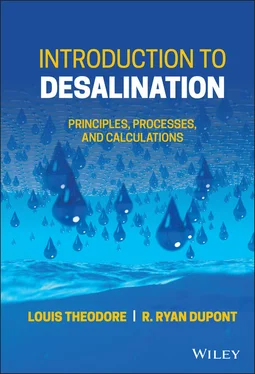1 ...6 7 8 10 11 12 ...24 1 In terms of the question “how much water is there?” explain why only approximately 0.3% of the entire water on the Earth is considered usable fresh water.
2 With so much water on the planet explain why there is a water availability and water supply crisis.
3 List and briefly describe the four major aquatic habitats in the United States and indicate concerns regarding contamination of these resources.
4 SIWI (2005) and Hares (2017) have made strong cases for the economic benefit of water infrastructure investments around the world. In the United States, the US Water Alliance (2017) outlined the way forward for ensuring all people have access to clean, affordable water, and all benefits from water infrastructure investments to make water supplies more reliable and resilient in the face of climate change pressures. Review the US Water Alliance (2017) national briefing paper on water equity and summarize the “Three Pillars” of water equity put forth in this document.
5 A comparison of global drinking water supply and sanitation services provided by WHO (2017) suggests that in 2015, North America had some of the highest rates of improved water supplies (96%) and basic sanitation (97%) and safely managed improved sanitation facilities (78%) in the world. The statistics for the United States are even higher at 99% of the population using improved water supplies, while 89% were using improved sanitation facilities. For those in the United States either not having access to improved water supplies or improved sanitation facilities, UNC Environmental Finance Center (2017) has indicated that conditions for them are similar to individuals in developing countries. Review the UNC Environmental Finance Center (2017) document on Clean Water Access Challenges in the United States and summarize the six major clean water access challenges they identified in twenty-first-century America.
1 Advameg, I. (2010). Encyclopedia of the Nations. Total renewable water resources – The World Factbook – CIA. http://www.nationsencyclopedia.com/WorldStats/CIA-Total-renewable-water-resources.html(accessed July 9, 2021).
2 Barnaby, W. (2009). Do nations go to war over water? Nature 458: 282–283.
3 Dictionary.com(2012). Desalination. Collins English Dictionary – Complete and Unabridged. New York, NY: Harper Collins Publishers. https://www.dictionary.com/browse/desalination. (accessed July 8, 2021).
4 Flynn, A.M., Akashige, T., and Theodore, L. (2019). Kern, Process Heat Transfer, 2nd Edition. Salem, MA: Schrivener-Wiley.
5 Fröhlich, C.J. (2012). Water: Reason for conflict or catalyst for peace? The case of the Middle East. L’Europe en Formation 365(3): 139–161. https://www.cairn.info/revue-l-europe-en-formation-2012-3-page-139.htm.
6 Gleick, P.H. (1996). Water resources. In: Encyclopedia of Climate and Weather (ed. S.H. Schneider), . 817–823. New York: Oxford University Press.
7 Grace Communication Foundation (2019). Water footprint comparisons by country. https://www.watercalculator.org/footprints/water-footprints-by-country. (accessed July 9, 2021).
8 Hares, S. (2017). The cost of clean water: $150 billion a year, says world bank. In: Reuters London, UK: Thomson Reuters Corporation. https://www.reuters.com/article/us-global-water-health/the-cost-of-clean-water-150-billion-a-year-says-world-bank-idUSKCN1B812E.
9 Kummu, M., de Moel, H., Ward, P.J., and Varis, O. (2011). How close do we live to water? A global analysis of population distance to freshwater bodies. PLoS One (6): e20578. https://www.ncbi.nlm.nih.gov/pmc/articles/PMC3110782.
10 Lufkin, B. (2017). Future – Why ‘hydro-politics’ will shape the 21st century. BBC Future Now. http://www.bbc.com/future/story/20170615-why-hydro-politics-will-shape-the-21st-century(accessed July 9, 2021).
11 McCrary, K. (2018). The politics of water development: A source of conflict? International association for political science students. http://www.iapss.org/wp/2018/02/28/the-politics-of-water-development-a-source-of-conflict(accessed July 9, 2021).
12 Mekonnen, M.M. and Hoekstra, A.Y. (2011). National Water Footprint Accounts: The Green, Blue and Grey Water Footprint of Production and Consumption. Volume 1: Main Report. Value of Water Research Report Series No. 50. Delft, The Netherlands: UNESCO-IHE Institute for Water Education. https://waterfootprint.org/media/downloads/Report50-NationalWaterFootprints-Vol1.pdf.
13 Mullen, K. (2021). Information on Earth’s Water. Westerville, OH: National Ground Water Association. https://www.ngwa.org/what-is-groundwater/About-groundwater/information-on-earths-water(accessed July 8, 2021).
14 Osborn, L. (2019). Number of reservoirs in the world. Current results. Weather and Science Facts. https://www.currentresults.com/Environment-Facts/number-reservoirs-in-world.php(accessed July 8, 2021).
15 Rekacewicz, P. (2006). Freshwater Resources: Volume by Continent. Arendal, Norway: GRID-Arendal. http://www.grida.no/resources/5608.
16 Stockholm International Water Institute (2005). Making Water a Part of Economic Development. The Economic Benefits of Improved Water Management and Services. Stockholm, Sweden: SIWI and the World Health Organization. https://www.siwi.org/wp-content/uploads/2015/09/waterandmacroecon.pdf.
17 Theodore, L. (2014). Chemical Engineering: The Essential Reference. New York, NY: McGraw-Hill.
18 Theodore, L., Dupont, R.R., and Ganesan, K. (2017). Unit Operations in Environmental Engineering. Salem, MA: Schrivener-Wiley.
19 Theodore, L. and Ricci, F. (2010). Mass Transfer Operations for the Practicing Engineer. Hoboken, NJ: John Wiley & Sons.
20 University of North Carolina Environmental Finance Center (2017). An Overview of Clean Water Access Challenges in the United States. Chapel Hill, NC: University of North Carolina at Chapel Hill Environmental Finance Center. https://efc.sog.unc.edu/wp-content/uploads/sites/1172/2021/07/An-Overview-of-Clean-Water-Access-Challenges-in-the-United-States.Final_.pdf.
21 US Water Alliance (2017). An Equitable Water Future. A National Briefing Paper. Washington, D.C.: US Water Alliance. http://uswateralliance.org/sites/uswateralliance.org/files/publications/uswa_waterequity_FINAL.pdf.
22 Water.org(2019). Brazil’s Water and Sanitation Crisis. Kansas City MO: Water.org. https://water.org/our-impact/brazil.
23 World Health Organization (2017). Progress on Drinking Water, Sanitation and Hygiene 2017. Update and SDG Baselines. Geneva. Switzerland: World Health Organization (WHO) and the United Nations Children’s Fund (UNICEF). https://apps.who.int/iris/bitstream/handle/10665/258617/9789241512893-eng.pdf;jsessionid=BFB5D93E1AC22CFE3A7EAB3C0F603BF9?sequence=1.
2 Technical Glossary
2.1 Introduction
This chapter provides definitions for many, but not all, of the terms that the reader will encounter in this book. It should be noted that some of the definitions specifically refer to the United States and that a good number of definitions pertain to wastewater and wastewater-related terms. It should also be noted that many of the terms have come to mean different things to different people, and this will become evident as one delves deeper into the applicable literature. Finally, the bulk of the material in this chapter was drawn from the earlier work of Theodore et al. (1997).
Absolute humidity – The amount of water vapor present in a unit mass of air, which is usually expressed as kilograms of water vapor per kilogram of dry air or pounds of water vapor per pound of dry air.
Absolute pressure – The actual pressure exerted on a surface that is measured relative to zero pressure; it equals the gauge pressure plus the atmospheric pressure.
Читать дальше












